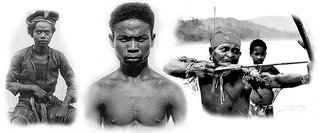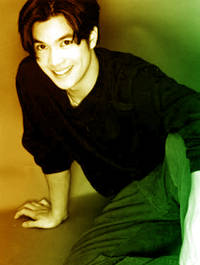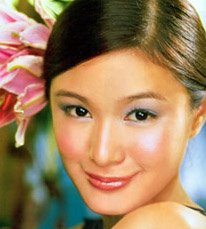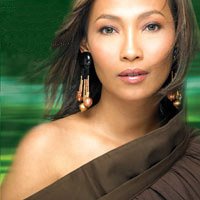Looking Back...Way Back



"Ang hindî marunong lumingón sa pinanggalingan ay hindî makararatíng sa paroroonan"
(He who does not know how to look back to where he came from will not get to where he is going )
I've been noticing that a lot of Filipinos call themselves Asian, especially those that grew up here in Canada. I've never believed that. We are Asians because of the fact that our archipelago is near the Asian continent, but are we Asians as a people? I look at us and we're an entirely different people with characteristics distinct from the rest of the Asian peoples. We value personal freedoms more than all other Asian countries (first democratic country in Asia), our women have an elevated place in our culture (border-lining matriarchal), we speak an Austro-Polynesian language, and we have a passion for life that doesn't exist anywhere else in Asia (or the world, for that matter). So in light of these observations I decided to investigate just what we are exactly.

We are technically Malay but "Malay" makes it seem like our ancient ancestors migrated to the Philippines coming from, and passing through mainland Malaysia, when in reality it is actually the other way around. The ancient ancestors of the Malaysians actually had to migrate through the Philippines to get to the continent. We came from the part of Malaysia that connects to Borneo. Malay is just an over-simplified word coined by a culturally ignorant American anthropologist named H. Otley Beyer. His term "Malay" signifies brown-skinned people who live in the Indian Archipelago, Micronesia, Austronesia and Australia. How ignorant. Brown-skinned peoples in those areas aren't necessary related. And for crying out loud, please pronounce it mal-eye, not mal-eigh. The latter sounds typically Anglophonic. Long story short, we are much more than just Malay.
The origins of the Filipino peoples are much more flavoured. The first settlers of the Philippines were the Aetas (or Itas) or Negritos in Spanish. They are a pygmy people who are very short -- even for Filipinos -- have dark-brown to black skin, and have curly black hair. Their history confounds even modern Anthropologists. They are believed to have migrated from the Andaman Islands in the Indian Ocean to the Philippines using the landbriges that used to connect the Southeast Asian islands together during the last Ice Age. The Negrito groups ultimately migrated from Eastern Africa. Aetas still live a culture very distinct from the rest of us Pinoys who sold out to shopping malls and skating rinks.

The majority of Filipinos, however, came from a different lineage than the Aetas. Between 55,000 to 60,000 years ago, a genetically-related group of people started migrating east from the East-African/Arabian Peninsula area. They always moved along the sea through what would be called Persia, India, the south of China (which wasn't Chinese then), Taiwan, and finally -- using boats -- they came to the Philippine Archipelago. After the first wave of migration, there were several other migration passages through the Philippine Islands. Some of the ancestors of these migrants eventually populated Indonesia, Polynesia, Micronesia, Austronesia, other Pacific islands such as Hawaii, and parts of East Asia. Yes, this is why it is very different to distinguish a Flip from a Hawaiian.
After the original migrations came a series of foreign exposures that really made Filipino culture one of the most colourful in the world. The inhabitants of the Philippines have, by this time, been exposed to the cultures and religions of South Asia and the Middle East. Between 750-1500 AD (Muslim Golden Age), the Filipinos came into contact with Arab seafarers and traders. They contributed greatly to technology, culture, and they brought Islam to the Islands. The Islanders had previously been animistic, worshipping spirits of nature. The Chinese and other seafaring Asiatic peoples also made trade contact.

The most significant cultural impact on the Philippines was the Spanish impact. Ferdinand Magellan met his end (and the pointy end of Lapu-Lapu's spear) on the Philippine island of Mactan. The Philippines became a Spanish colony for 300 years. The Philippines was actually named after Philip II of Spain. Catholicism became the dominant religion, making the Philippines the only nominal Christian country in Asia. The Spanish established Manila as a major connecting port to Mexico, through which the Philippines was exposed to the Native South Americans and the rest of the known world. During the Spanish-American War, the Philippines was ceded to the States, and remained so until after WWII. PX Shopping was introduced and was enthusiastically welcomed by the Filipinos (and mourned when the states withdrew their bases). During the American occupation, Evangelical Christianity was brought to the Philippines and remains strong in the Philippines...and in me!

Now... I have to say that Filipinos don't discriminate when it comes to the birds and the bees, so logically all this foreign contact made a lot of colorful babies. Very few Filipinos are purely Filipino. This is why Filipinos have facial features which are distinctly Filipino, but from other angles seem Caucasian, Near-eastern, Asiatic, African, and even Mayan (South America).



Other clues to the origins of the Filipinos are the languages that they speak. Tagalog, like the majority of the Filipino languages and dialects, belongs to the Malayo branch of the Austro-Polynesian language group. Other members of this language group include Indonesian, Malay, Fijian, Maori (of New Zealand), Hawaiian, Malagasy (of Madagascar), Samoan, Tahitian, Chamorro (of Guam and the Northern Mariana Islands), Tetum (of East Timor), and Paiwan (of Taiwan). This is in contrast to the Sino-Tibetan languages that dominate the rest of Asia. These Sino-Tibetan languages which include, and are related to, Chinese, use pitchy vowels and a nasal quality that is very infrequent in Tagalog. The Sino-Tibetan languages also use complicated semi-pictographic characters which are quite unlike the ancient Baybayin script of pre-Spanish Philippines which is more related to the Near-Eastern and Sanskrit scripts. Linguistically, Filipinos are not Asian.

The kaleidoscope of cultures which made up the Philippines began to evolve within the Philippines, as the archipelago is made up of 7100 islands which can isolate groups of people from the rest of the Philippines. As a result, the Philippines developed over 170 different groups of cultures and languages. We developed into a category of our own.

Although we are somewhat related to other Asians, Filipinos deny large parts of their history when they call themselves Asian. I think that the cultural inferiority complex possessed by many Filipinos leads many of them to identify ourselves with other cultures, resulting in the diminishment of our own. I say sucks to that. Filipinos should start making names for themselves. We can't rely on Lea Salonga and Rob Schneider to do that for us. There has to be more of us. If no other Filipino will, then I will rise to greater heights than any of us have ever risen to. I refuse to rest comfortably in insignificance.
Asians? psshhaw. I think that calling ourselves Filipino should suffice.

...now i just need to find out why I look like I came out of Ancient Egypt.


<< Home